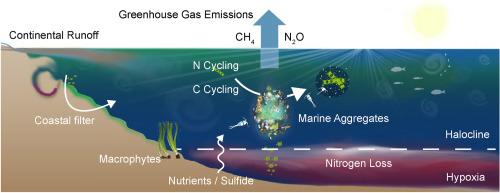Coastal zones of the Baltic Sea in the Anthropocene: Current state and the impact of climate change
IF 2.6
3区 地球科学
Q1 MARINE & FRESHWATER BIOLOGY
引用次数: 0
Abstract
Coastal zones and estuaries are highly dynamic marine systems subject to anthropogenic pressure and to climate-related changes. The coastal zone of the Baltic Sea, shaped by extreme seasonality, strong bentho-pelagic coupling, and intense human use, represents a unique model system to study these interactions under accelerating climate change. While extensive research has been conducted on warming, eutrophication, and large scale hypoxia in the region, critical gaps remain in understanding how physical forcing, sediment type, and benthic–pelagic coupling control nutrient turnover, primary production, seed and egg bank dynamics, and the emission of climate-relevant gases under rapidly changing dynamic conditions. The Baltic Sea, with 26 % of its area shallower than 15 m, harbor mostly sandy sediments along the southern coast, but the coastal nutrient filter remains poorly investigated because element fluxes are mostly controlled by advection. Sediments are home for phytoplankton resting stages, but the contribution of seed germination to the development of phytoplankton blooms is unknown. The resting eggs of zooplankton are also deposited in the sediment, but the timing of zooplankton and fish development in spring and the impact of progressive warming are poorly understood. Decreases in salinity strongly influence macrobenthos in the Baltic Sea, whereas increased eutrophication favors the growth of opportunistic species. Finally, coastal darkening is discussed, as it affects marine life in ways that are difficult to assess. Future studies of coastal zones will benefit from technical innovations like mooring systems that transmits data immediately to the shore and uses drones to aid in sampling along coastlines. This review synthesizes current knowledge on the state and functioning of the Baltic coastal zone, highlighting novel insights into the role of permeable sandy sediments as nutrient cycling hotspots. We identify key uncertainties arising from the high spatio-temporal variability of these systems, which limit the predictive capacity of existing models. Only by combining novel approaches we can improve projections of climate-change impacts, and provide a robust scientific basis for the management and protection of vulnerable coastal ecosystems. Accordingly, the measures that will enable stakeholders and politicians to improve the protection of coastal areas remain to be developed.

波罗的海海岸带在人类世:现状和气候变化的影响
海岸带和河口是高度动态的海洋系统,受到人为压力和与气候有关的变化的影响。波罗的海海岸带受极端季节性、强烈的底-上层耦合和强烈的人类利用的影响,为研究加速气候变化下这些相互作用提供了一个独特的模式系统。虽然对该地区的变暖、富营养化和大规模缺氧进行了广泛的研究,但在快速变化的动态条件下,物理强迫、沉积物类型和底-上层耦合如何控制养分周转、初级生产、种子和卵库动态以及气候相关气体排放方面仍存在重大空白。波罗的海26%的面积小于15米,南部海岸主要是沙质沉积物,但沿海营养物质过滤器的研究仍然很少,因为元素通量主要由平流控制。沉积物是浮游植物休眠阶段的家园,但种子萌发对浮游植物华生长的贡献尚不清楚。浮游动物的休眠卵也沉积在沉积物中,但浮游动物和鱼类在春季发育的时间以及逐渐变暖的影响尚不清楚。盐度的降低强烈影响波罗的海大型底栖动物,而富营养化的增加有利于机会性物种的生长。最后,讨论了海岸变暗,因为它以难以评估的方式影响海洋生物。未来对沿海地区的研究将受益于技术创新,比如将数据立即传输到岸上的系泊系统,以及使用无人机帮助沿海岸线采样。这篇综述综合了目前关于波罗的海海岸带状态和功能的知识,突出了对渗透性沙质沉积物作为养分循环热点的作用的新见解。我们确定了这些系统的高时空变异性引起的关键不确定性,这限制了现有模型的预测能力。只有结合新的方法,我们才能改善对气候变化影响的预测,并为管理和保护脆弱的沿海生态系统提供坚实的科学基础。因此,使利益相关者和政治家能够改善沿海地区保护的措施仍有待制定。
本文章由计算机程序翻译,如有差异,请以英文原文为准。
求助全文
约1分钟内获得全文
求助全文
来源期刊
CiteScore
5.60
自引率
7.10%
发文量
374
审稿时长
9 months
期刊介绍:
Estuarine, Coastal and Shelf Science is an international multidisciplinary journal devoted to the analysis of saline water phenomena ranging from the outer edge of the continental shelf to the upper limits of the tidal zone. The journal provides a unique forum, unifying the multidisciplinary approaches to the study of the oceanography of estuaries, coastal zones, and continental shelf seas. It features original research papers, review papers and short communications treating such disciplines as zoology, botany, geology, sedimentology, physical oceanography.

 求助内容:
求助内容: 应助结果提醒方式:
应助结果提醒方式:


